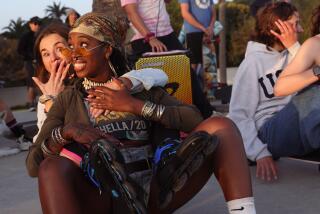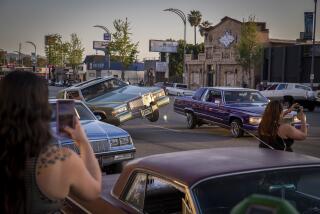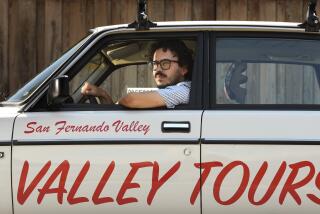At Hurley show, surf, skate and lowrider worlds meet up
- Share via
It was easy to miss a small black-and-white photo on the wall next to the blazing, glossy aesthetic of a deep-orange-and-red Chevy Impala known as El Rey.
The 1963 convertible is regarded as a pinnacle of modern lowrider culture, and even under low light, the car glittered inside a small showroom at surfwear company Hurley’s headquarters in Costa Mesa on Saturday.
But almost unnoticed a few feet away, blending into the poster-lined walls, hung a picture that explained why El Rey, which means “the king” in Spanish, was there.
“Lowriders, they used to park on the hills in L.A. and San Diego, and they would watch the skaters bomb the hills,” said Hurley employee Dakota Gomez. “Then it would be vice versa; the skaters would watch the lowriders cruise. And it’s all by the beach.”
He pointed to the picture taken in 1976 that shows a skateboarder balanced on his rear wheels as he rolls by two men leaning on a lowrider in front of a graffiti-covered backdrop.
The ethos of that picture, taken by iconic skate photographer and artist Craig Stecyk, rolled into Hurley’s headquarters as part of the Legacy show.
El Rey was at the center of a maze of dozens of lowriders lining the corporate campus. They were the visual thread used to connect other pieces of Los Angeles and Orange County street and surf culture on display.
“Lowrider guys are fascinated with surf and skate, and surf and skate are fascinated with these cars — California all in one place in one day,” Gomez said.
Inside a lobby at the front of the campus, exhibitors had blended that shared fascination.
Graffiti, tattoo and lowrider artists — including El Rey’s owners Albert de Alba Sr. and Albert de Alba Jr. — had painted six surfboards. The purple and black strokes on the Albas’ board evoked El Rey’s own lines.
In a nearby room, a wall covered in decades-old skateboards melded surf and skate history.
“These are all sidewalk surfboards,” said Jason Cohn.
Cohn and his counterparts at a company appropriately called Scavenger scour garage sales and flea markets for skate relics to help them document the sport’s evolution from surfing.
“Skateboarding was basically an activity founded out of necessity or boredom,” he said. “When the surf conditions were poor, they needed something to do.”
That led to boards like ones Cohn has found dating back to the 1950s made out of fence posts or scavenged planks.
“You take a piece of wood out of your father’s woodshed, traced a surf shape around it, take your sister’s roller skate, cobble it together, and all of a sudden you are free,” he said.
One of Cohn’s finds even bridged the gap to the lowriders outside. Its sparkling blue, pillowy deck stood out against the other boards’ wood grains and painted reds.
“This is tuck-and-roll fabric you might see in the back seats of the upholstery of cars,” he said. “They put barefoot kids on this to show that it’s a great surface even when it gets hot and had kids skating these things.”
Much like Hurley’s show, it represented a beach culture of cars, skating and surfing tied up in one intertwined package.
“It’s a celebration of California tradition,” Gomez said.
Twitter: @jeremiahdobruck
More to Read
Sign up for Essential California
The most important California stories and recommendations in your inbox every morning.
You may occasionally receive promotional content from the Los Angeles Times.











